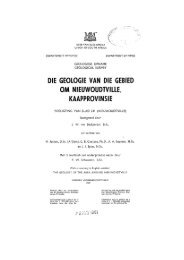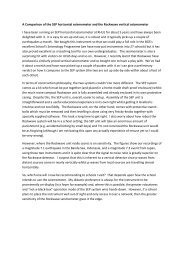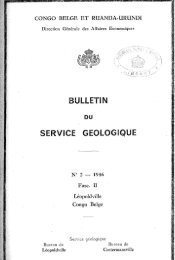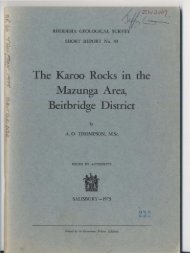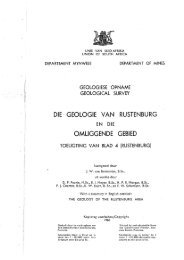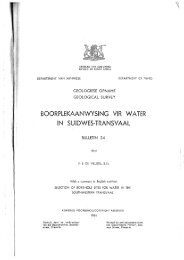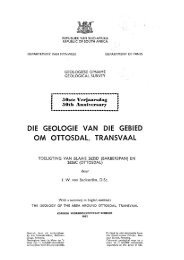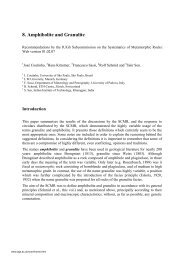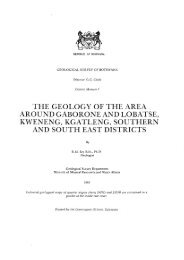Bibliography - British Geological Survey
Bibliography - British Geological Survey
Bibliography - British Geological Survey
Create successful ePaper yourself
Turn your PDF publications into a flip-book with our unique Google optimized e-Paper software.
verify and interpret these curious discoveries, alleged, with irritation, that the records of the work were<br />
imprecise to the point of being virtually useless.’ See comments by Houghton 1981)<br />
Holliday, R. & Williams, P. 1978. Professor is named as Piltdown hoaxer. Sunday Telegraph, 29 Oct, front<br />
& back pages. (The Sunday Telegraph appears to have been the first newspaper to publish Beverley Halstead’s<br />
presentation of Prof. James Douglas’s ‘evidence’ implicating Prof. W. J. Sollas as co-conspirator with Dawson<br />
in the Piltdown fraud. Douglas’s assertion is contained in a 20-minute tape recording, parts of which are here<br />
quoted, together with remarks from Richard Ford, an amateur palaeontologist who prompted Douglas to make<br />
the recording. Douglas died on 27 Feb 1978. See Halstead 1978. The Daily Telegraph also ran a feature the<br />
following day by R. B. O’Brien entitled ‘‘Brains’ behind Piltdown Man hoax is named’)<br />
Hooton, E. A. 1916. The evolution of the human face and its relation to head form. Dental Cosmos, 58,<br />
272–281. (Eoanthropus, pp. 277–278)<br />
Hooton, E. A. 1931. Up from the ape. New York: Macmillan, xvii,626 pp. (Dame Eoanthropus: the first<br />
female intellectual, pp. 302‒314; a detailed analysis of the skull and jaw of the ‘Piltdown lady’, the integrity<br />
of which is not doubted by the writer, who was Professor of Anthropology at Harvard University.)<br />
Hooton, E. A. 1954. Comments on the Piltdown affair. American Anthropologist, 56 (Apr), 287–289.<br />
(Expresses reservations about the accuracy of the tests undertaken by Oakley and his team)<br />
Hopwood, A. T. 1935. Fossil elephants and man. Proceedings of the Geologists’ Association, 46 (1), 46–60.<br />
(Piltdown, pp. 47–51: the writer has made a fresh examination of the Piltdown mammalian fauna and believes<br />
that the human remains, judged purely on their state of preservation, more properly belong with that part of<br />
the assemblage which has been assigned to the Pliocene and includes Mastodon and Elephas cf. planifrons.)<br />
Hopwood, A. T. (see also Osborn 1942)<br />
Horst, M. 1921. Ein zweiter “Halbmenschen”-Fund von Piltdown. Neuw Weltanschauung, 10, 72–77.<br />
Hoskins, C. R. & Fryd, C. F. M. 1955. The determination of fluorine in Piltdown and related fossils.<br />
Journal of Applied Chemistry, 5 (Feb), 85–87.<br />
Hoskins, C. R. (see also under Oakley)<br />
Houghton, J. 1981. The Lavant Caves. Sussex Archaeological Society Newsletter, no. 35 (Dec), 253. (With<br />
reference to comments by Holden 1981, who asks, in the light of an article that appeared in the Sunday Times<br />
in 1953, whether any reliance can be placed on Charles Dawson’s manuscript account of the Lavant Caves<br />
excavation, Houghton points out that doubts raised in the Sunday Times were based on statements alleged to<br />
have been made by L. F. Salzman, who subsequently wrote to the newspaper (Salzman 1953) stating that the<br />
allegation was ‘completely untrue’.)<br />
Howard, P. 1974. History is lies―ask the Piltdown Man. The Times, 30 March, 14. (Article prompted by<br />
the findings of Lieutenant-Colonel P. B. S. Andrews of Maresfield Park, who has shown that a purported<br />
historical map of the Maresfield Forge, credited to Charles Dawson, is a forgery. The article is evidently<br />
based on an interview with Andrews and led to the publication of a fuller account by him in the Sussex<br />
Archaeological Collections for 1974, although Andrews had died by the time of its appearance.)<br />
Howells, W. 1947. Mankind so far. American Museum of Natural History Science Series, 5, xii, 319 pp, 7<br />
plates. (Considers that the evidence in regard to Piltdown Man has become so confused that no definite<br />
decision can be advanced concerning its status)<br />
Hrdlička, A. 1914. The most ancient skeletal remains of man. Annual Report of the Smithsonian Institution,<br />
for 1913, 491–552, 41 plates. (The “Eoanthropus Dawsoni”, pp. 501–509, plates 5–8, being a summary of<br />
published findings. At the time of writing, Hrdlička had been unable to examine any of the Piltdown material<br />
at first hand and thus could offer no original observations.)<br />
Hrdlička, A. 1916. The most ancient skeletal remains of man. 2nd ed. Washington : Smithsonian<br />
Institution, Publication no. 2300, 63 pp.<br />
Hrdlička, A. 1922. The Piltdown jaw. American Journal of Physical Anthropology, 5 (4), 337–347. (During<br />
a recent visit to London the writer was able to undertake a close and lengthy examination of the Piltdown jaw<br />
and skull. He was struck by a strong feeling of incongruity and lack of relationship between the two parts.



